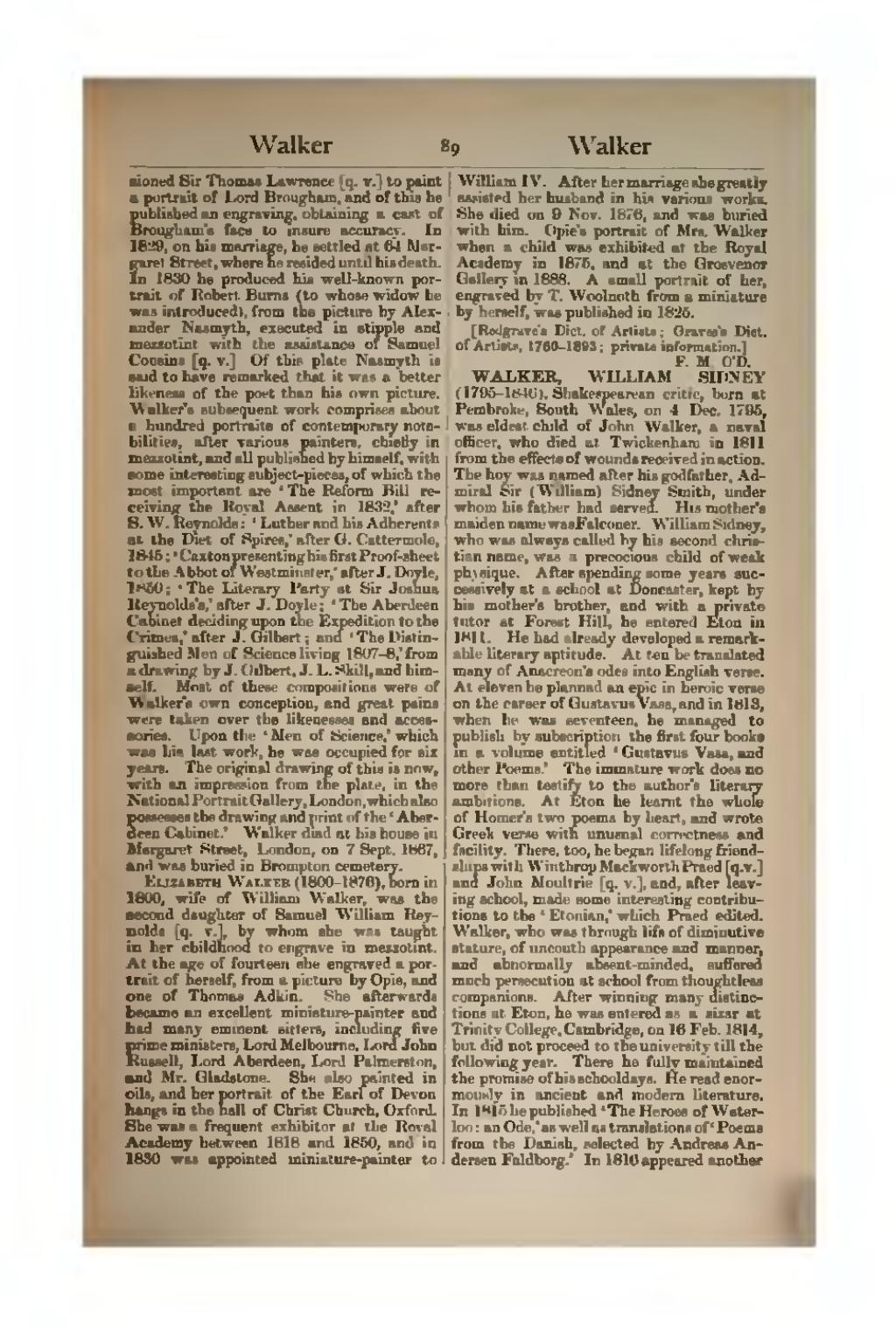sioned Sir Thomas Lawrence [q. v.] to paint a portrait of Lord Brougham, and of this he published an engraving, obtaining a cast of Brougham's face to insure accuracy. In 1829, on his marriage, he settled at 64 Margaret Street, where he resided until his death. In 1830 he produced his well-known portrait of Robert Burns (to whose widow he was introduced), from the picture by Alexander Nasmyth, executed in stipple and mezzotint with the assistance of Samuel Cousins [q. v.] Of this plate Nasmyth is said to have remarked that it was a better likeness of the poet than his own picture. Walker's subsequent work comprises about a hundred portraits of contemporary notabilities, after various painters, chiefly in mezzotint, and all published by himself, with some interesting subject-pieces, of which the most important are ‘The Reform Bill receiving the Royal Assent in 1832,’ after S. W. Reynolds; ‘Luther and his Adherents at the Diet of Spires,’ after G. Cattermole, 1845; ‘Caxton presenting his first Proof-sheet to the Abbot of Westminster,’ after J. Doyle, 1850; ‘The Literary Party at Sir Joshua Reynolds's,’ after J. Doyle; ‘The Aberdeen Cabinet deciding upon the Expedition to the Crimea,’ after J. Gilbert; and ‘The Distinguished Men of Science living 1807–8,’ from a drawing by J. Gilbert, J. L. Skill, and himself. Most of these compositions were of Walker's own conception, and great pains were taken over the likenesses and accessories. Upon the ‘Men of Science,’ which was his last work, he was occupied for six years. The original drawing of this is now, with an impression from the plate, in the National Portrait Gallery, London, which also possesses the drawing and print of the ‘Aberdeen Cabinet.’ Walker died at his house in Margaret Street, London, on 7 Sept. 1867, and was buried in Brompton cemetery.
Elizabeth Walker (1800–1876), born in 1800, wife of William Walker, was the second daughter of Samuel William Reynolds [q. v.], by whom she was taught in her childhood to engrave in mezzotint. At the age of fourteen she engraved a portrait of herself, from a picture by Opie, and one of Thomas Adkin. She afterwards became an excellent miniature-painter and had many eminent sitters, including five prime ministers, Lord Melbourne, Lord John Russell, Lord Aberdeen, Lord Palmerston, and Mr. Gladstone. She also painted in oils, and her portrait of the Earl of Devon hangs in the hall of Christ Church, Oxford. She was a frequent exhibitor at the Royal Academy between 1818 and 1850, and in 1830 was appointed miniature-painter to William IV. After her marriage she greatly assisted her husband in his various works. She died on 9 Nov. 1876, and was buried with him. Opie's portrait of Mrs. Walker when a child was exhibited at the Royal Academy in 1875, and at the Grosvenor Gallery in 1888. A small portrait of her, engraved by T. Woolnoth from a miniature by herself, was published in 1825.
[Redgrave's Dict. of Artists; Graves's Dict. of Artists, 1760–1893; private information.]
WALKER, WILLIAM SIDNEY (1795–1846), Shakespearean critic, born at Pembroke, South Wales, on 4 Dec. 1795, was eldest child of John Walker, a naval officer, who died at Twickenham in 1811 from the effects of wounds received in action. The boy was named after his godfather, Admiral Sir (William) Sidney Smith, under whom his father had served. His mother's maiden name was Falconer. William Sidney, who was always called by his second christian name, was a precocious child of weak physique. After spending some years successively at a school at Doncaster, kept by his mother's brother, and with a private tutor at Forest Hill, he entered Eton in 1811. He had already developed a remarkable literary aptitude. At ten he translated many of Anacreon's odes into English verse. At eleven he planned an epic in heroic verse on the career of Gustavus Vasa, and in 1813, when he was seventeen, he managed to publish by subscription the first four books in a volume entitled ‘Gustavus Vasa, and other Poems.’ The immature work does no more than testify to the author's literary ambitions. At Eton he learnt the whole of Homer's two poems by heart, and wrote Greek verse with unusual correctness and facility. There, too, he began lifelong friendships with Winthrop Mackworth Praed [q. v.] and John Moultrie [q. v.], and, after leaving school, made some interesting contributions to the ‘Etonian,’ which Praed edited. Walker, who was through life of diminutive stature, of uncouth appearance and manner, and abnormally absent-minded, suffered much persecution at school from thoughtless companions. After winning many distinctions at Eton, he was entered as a sizar at Trinity College, Cambridge, on 16 Feb. 1814, but did not proceed to the university till the following year. There he fully maintained the promise of his schooldays. He read enormously in ancient and modern literature. In 1815 he published ‘The Heroes of Waterloo: an Ode,’ as well as translations of ‘Poems from the Danish, selected by Andreas Andersen Feldborg.’ In 1816 appeared another
